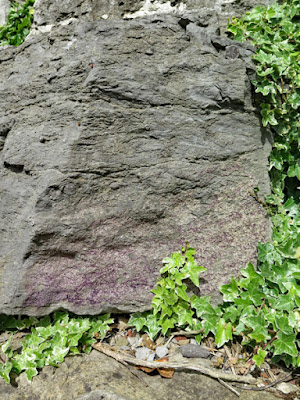 |
| An inscribed monolith at Finchwell Road |
Continuing my walk from Normanton Hill to Treeton, during the COVID-19 Pandemic, my next stop after St. Joseph’s church was Handsworth Community Park, a green space that I had identified on Google Map when looking for new places to visit.
Arriving at the St. Joseph’s Road entrance, I was interested to see the large, irregular monolithic blocks of Coal Measures sandstone, which have been roughly shaped and tooled – reminding me of similar landscaping that I seen at Manor Fields Park and along City Road in Sheffield.
I didn’t stop to closely examine the sandstone, but the dense accumulation of iron oxides and hydroxides on the bedding and jointing planes is a feature of very many sandstones found in the Pennines and adjoining areas.
Although there once very many quarries in the Sheffield area, producing stone for local needs, they have long since closed and it is quite possible that the stone used here was brought from West Yorkshire, which is still a major supplier of Carboniferous sandstone.
Sheffield is one of the greenest cities in Europe and has very many public parks and green spaces, some of which are Registered Parks and Gardens, this is only a local community space, with football pitches and other sports facilities and a children’s play area.
The well equipped play area, however, has many other examples of similar monolithic blocks that still retain drill marks, where very large blocks were split into smaller ones using plug and feathers. Like those at the entrance, some of these are tooled to various degrees and, in a couple of places, these have been shaped into swords.
To the east, at a distance of 2.5 km, the tower of St. Helen’s church in Treeton can be made out and the ridge of “Rotherham Red” sandstone, which forms the skyline, stretches from Canklow Woods in Rotherham to beyond Ulley.
When I first moved to Treeton back in 1997, and for several years after, these views were obscured by a vast mound of waste from Orgreave Opencast Coal Mine, which occupied the low ground and whose extent is marked by the hatched markings on the geological map.
After taking a few photos of the views that I could now see, I left the park and carried on down to the railway line and after crossing the bridge finished my walk by having a quick wander through the Waverley Estate – a vast, soulless housing development that is now in its place.
 |
| A monolith at Finchwell Road |






















































